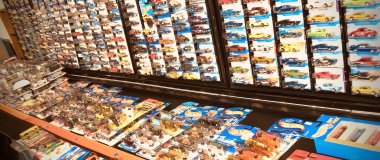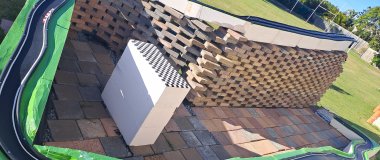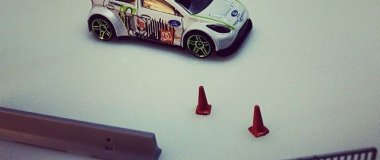Racing into yesteryear, the story behind Flintrock Highway

Back in February, a build journal was started for a track named Flintrock Highway. It started out looking like many other diorama track builds but after only a few days, it was clear that Flintrock Highway was heading a slightly different direction.
For one, it was a short track...like, 4-feet type of short. But the real unique aspect of Flintrock is the olde timey, steampunk theme. It's just not an aesthetic you see a lot in diecast racing tracks. We see a lot of modern-day style and some great apocalypse/distopia themes, but I thought this yesteryear idea was really different and great to see. And then after a couple weeks, Flintrock Highway was almost finished and ready to race.
The man behind Flintrock Highway is Ian Pitts, also know as Rainsford here on Redline Derby. He's a relatively new member to the community but is already leaving his mark with a great track build that's certain to inspire many others along the way.
I asked Ian to share a bit about himself and his journey into the wonderful world of diecast racing...and talk a bit about his track, of course.
Interview with Ian Pitts of Flintrock Highway
Redline Derby: Let's start with the basics...who you are, where you are, what you do, and what's your favorite breakfast cereal?
Ian Pitts: I’m Ian, my steampunk alter ego is Theodore “Casey" Rainsford, and I live in Lawrence, Kansas. I work in historic preservation with an architectural background, and have been an avid history buff since childhood. The new Honey Oat Crunch Cheerios are delicious.
RLD: The first thing anyone will notice about Flintrock Highway is the theme: olde timey with some steampunk vibes. What's your history with steampunk and that yesteryear aesthetic?
IP: My wife and I have been into steampunk for about a decade - there was a steampunk club at our university we helped found, and several local steampunk conventions we attended. With history as my passion, steampunk (or Victorian Science Fiction) was a natural progression and a fun way to play with a historic aesthetic for futuristic designs and adventure storytelling. I’m sure Back to the Future Part III was an early childhood influence in my steampunk aesthetic, but things like Sky Captain and the World of Tomorrow (dieselpunk) and The Great Race are movies that have also influenced me. A lot of steampunk takes on a darker dystopian aesthetic with megacities covered in soot, but I really enjoy the more comedic and brightly colored takes on the genre.

RLD: You talked in your build journal about some of your experience with model trains. How long have you been doing modeling, dioramas, trains, etc.? What about it has kept you active in the hobby?
IP: I’ve been playing with model trains since I was probably about 3 years old. My dad remembers getting out his old Marx O-gauge train set and running it for me until the wheels almost completely fell off. When I was four, I ended up with a Lionel O-gauge “Micro Racers” set and an HO Bachmann set for Christmas. I’ve been modeling in various train scales ever since.
With my Hot Wheels as a kid, I was “up-cycling” before that was a word, turning milk cartons and boxes into cities that filled my bedroom. The sheer variety of inspiration you can get from the variety of railroads and locales in the real world is what has kept me active in the modeling hobby. Every time I pick up a history book or a model railroading magazine, the list of things I’d like to build a model of just gets longer!
RLD: Like many others over the past year, your introduction to diecast racing was the 3DBotMaker channel on YouTube. His track and videos are really great, but what did you see there got you hooked and made you say, "I want to do something like that”?
IP: His level of scenery craft is on par with what you see on model railroads, and I had never thought of combining that with diecast cars before. I’ve had the idea of building a steampunk train race model railroad knocking around for a while, as a way to get something interactive for kids at model train shows. I realized that I could test out a lot of my design ideas with diecast racing, work out a “Steampunk Racer” aesthetic, and not have to plunge into the expense of a large modular model railroad build right away.

RLD: Flintrock Highway is built on the top of a bookshelf. In a world of big tracks with twists and turns, your short track is pretty unique. Was using such a small footprint a design choice, or was it dictated by the space you had available in your home?
IP: Designing in a small space was both a design choice and dictated by the space available. Living in an apartment doesn’t leave much room for a big winding mountain track, even one that could be packed away when not in use. I also really love doing highly detailed scenes in a small space - in model railroading there is a whole segment of the hobby that pursues building “micro layouts” in four square feet or less that still depict an operational railroad. This is my way of taking that aesthetic into diecast racing - getting the most out of a small space. It’s been compared with writing a haiku poem - every element has to count!
RLD: The jump from model railroading to diorama diecast racing doesn't seem that great, but what have you found to be the biggest adjustments and considerations you've had to make for diecast racing? What's been the biggest challenge building your race track?
IP: Dealing with the physics of unpowered models is probably the biggest adjustment - having a gradual slope to the track means there are some cars that won’t make it to the finish line, and it can be surprising sometimes which ones those are. I discovered pretty quickly that choosing to paint the track meant things would run a little slower as well, since the slight roughness of the paint adds to the friction.

RLD: When I was model railroading and even working with slot cars, I always found that the planning, designing, and building was far more fun than the actual operation of the trains/cars. My problem then was I was always looking ahead to the next build rather than enjoying the current build. I mention all that to ask if you intend to keep Flintrock Highway around for a while or if you'll be itching to rebuild it and create a new track/scene for diecast racing?
IP: Since I planned it to come apart in modules, it is easy to store, and actually packs away after every use so the kitten doesn’t get to play Catzilla on it overnight! My wife is planning a modular extension down the front of the bookcase, so Flintrock will stay around for a while for that. The minimalist designer in me is itching to build a European style F1 track with simple fenced right-of-way and evenly spaced boulevard trees - giving the look of the early racing arcade games that were still around when I was a kid. It would be modular too, so there’s no reason they won’t be able to co-exist.
RLD: What aspects of your track are you particularly proud of? What were some of the "happy accidents" in your track build, if any?
IP: I am really happy with the hill at the finish line - the Life-Life HO scale homestead has been one of my favorite model building kits for a long time, but I never managed to build a railroad where it fit in well. So, now it has a whole racetrack designed around it being a main feature!

RLD: What tools, tricks, techniques, or processes helped you the most when building the track?
IP: Building with cardboard and hot glue is what enabled me to get the track up and running quickly. I picked up the idea for the technique from the "T-Trak" N scale modular railroading community. T-Trak modules are made to sit on folding tables at model train shows, and are small and lightweight enough that they are very easy to build, detail, and transport. I’ve seen several folks build very realistic and sometimes large modules using layered cardboard and hot glue with an internal grid, that survive traveling to multiple shows. Cheap and effective!
RLD: I get a lot of eyerolls and "whatevers" when the topic of diecast racing comes up with my wife, but what's been your wife's (and your family's) response and involvement in your track build?
IP: My wife was all in on the idea after we watched 3DBotmaker’s videos. She’s always been more of a car girl than into trains, so this kind of model making is something we can both get involved in. We share a lot of other hobbies like tabletop gaming and making costumes for comic conventions, so it’s nice to have something new to share as well. She declared my laned drag-strip track too gentlemanly, and so after we bought a Crash Racers set, she’s working on designing an extension down the front of the bookshelf that will take the track through an abandoned salt mine and a speakeasy hidden inside.
RLD: You've put a ton of work into the track already and it looks wonderful, but what's next for Flintrock Highway? What's still on your wishlist? What's left that you would like to explore?
IP: I’m currently working on completing the scenery details across the entire track, and finishing up the new town module I inserted after we bought the Crash Racers track. The town is using the crossing piece as an intersection that the future track extension through the mine can be attached to. Beyond that, I have a plethora of steampunk car builds that I want to do, and I’m always searching the racks for anything that might be a good base casting to start from. (A Porche 917LH is currently on the bench getting a boiler installed, so they don’t always have to be an “old time” casting!)

RLD: I include your track in a pretty short list of unique diorama tracks. For those folks that will be inspired by your track, how would you suggest they go about starting a build like yours? Particularly if they don't have previous experience with modeling otherwise?
IP: My best advice is to use YouTube to its full potential. Ten years ago I would have tried to come up with the best model railroad scenery book I could think of, but now if there is a kind of terrain feature you would like to create, you can simply search for it on YouTube and find multiple how-to videos, especially from the wargaming community. That leads to my second-best piece of advice - always remember that techniques from one modeling hobby can be applied to others. Cross-pollination always leads to a better build, no matter what you’re working on.
RLD: I know I'm one of many that are very interested in racing down Flintrock Highway. Do you have any intentions of opening it up for mail-in races or is the plan to keep racing local?
IP: Once I get the town module complete, I’m planning to start making YouTube videos, and once I get that process down I’m definitely thinking of doing some mail-in races, with vintage and steampunk themes!
RLD: Any other stories or shoutouts you want to mention?
IP: I found a trove of free 1/64 paper buildings to use for the town at the Papermau blog. He has quite a large category of 1/64 models, designed by himself and others around the internet, and if you donate to support the blog he will make you a 1/64 garage diorama with a custom building style and name of your choice. He’s currently working on a “Rainsford Bros. Garage” that will be the centerpiece of the town of Flintrock! I suggest you check his blog out if you’re in need of free buildings or backdrops for dioramas or your track!
I want to thank Ian for the taking the time to talk about his "new" hobby of diecast racing, and for pulling back the curtain a bit on his interests and his track build.
If you haven't yet, be sure to read through the Flintrock Highway Build Journal to see more great photos of the build and for tips and tricks on how it was built.





Great questions, and thanks to Ian for sharing his answers (and talent) with us all!